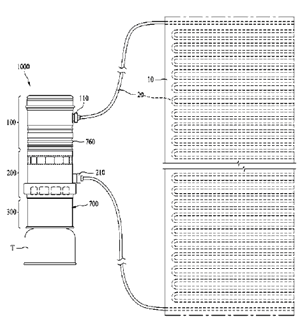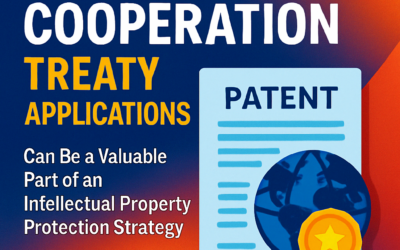Outdoor exploration and camping has seen a strong surge in popularity as the technology to support survival and progress in the outdoors has improved, allowing a wider and less experienced audience to experience the outdoors firsthand. Some of the technology that exists currently has been around for decades, including everything from portable stoves to tents. However, advancements in technology have improved everything from the technical fabrics for clothes to self-recharging batteries. Some key technological advancements as seen through patents and patent applications are shown below.

US Patent Application 2014/0335380 (Riggs) discloses a self-recharging battery based upon the benefits of magnesium air fuel cell technology. As seen above, Riggs discloses a self-recharging battery 100, with a casing side 125, protruding connector 112, and AA sized rechargeable battery 270 disposed within the casing side. Positive ends of the rechargeable battery match up to the external protruding connector 112 in order to transmit the stored energy of the battery for powering a device. When not in use however, the magnesium air fuel cell begins to charge the battery independently. When attached to device, the self-recharging battery functions as a regular battery due to an insufficient amount of air available for the fuel cell to function properly. This devices provides remote power and regeneration without the need for access to an electric grid or even solar power, a key support system when used in outdoor recreation for everything from powering a GPS to a flashlight.

US Patent 8,893,708 (Cho) discloses a portable boiler for a hot mat. The portable boiler for a heating mat provides a portable means for providing heat to a sleeping bag or mat during camping in a severely cold environment. The portable heating unit will provide a regulated temperature for sleeping to ensure camping in very cold temperatures remains feasible and safe. The portable boiler 1000, as shown above, provides a heating mat 10, water reservoir 100 a heat transfer unit 200, a heating part 300, and housing 700. The water reservoir stores circulating water received through an inlet of the reservoir. The heat-transfer part allowed the circulating water to flow past the heat exchanger and exit out of the outlet. This device could allow for the safe and significantly more comfortable experience of camping in cold weather conditions, while maintaining a safe environment for the body during sleep.

US Patent 8,869,814 (Jin) provides an innovation to the typical tent configuration for promoting improved ventilation to the users inside. Preferably, the tent structure includes a general pole structure commonly used in “instant” tents, a lower section comprising the walls of the tent, and an upper section comprising a dual inner and outer layer. As illustrated in the figure above, the lower section 20 includes four walls 21 and a floor 26. The upper section 30 forms an inner layer 31 and an outer layer 33 which provides the improved ventilation to the interior of the tent. The upper section of the tent provides an air permeable inner layer while the durable outer layer provides the necessary protection from the environment, precipitation, insects, and heat. In this method, the volume of space allocated at the top of the tent enables an increased level of ventilation while still providing the tent protection that campers have become accustomed to.

US Patent 8,701,840 (Allen) describes an innovative self-belay device for user by solo-climbers. The system provides for mitigating and controlling climbing movements with a rope as well as descending in a controlled manner down the rope. The system includes the self-belay device 10, a braking unit 12 mounted on a friction-less track 14. The braking unit and the track are disposed with a casing 16. Sliding carts 20 are positioned on the braking unit 12 and are enabled to freely slide along the track 14 between first and second positions. The main difference separating this device from typical belay devices is the fact that it is a self-belay device, needing only the climber for proper operation. As light tension is engaged on the rope, when ascending, the rope is fed through the system. However, if higher tensions is engaged, a clutch will automatically lock the rope mechanism, as in the situation of a climber falling. This system encases the entire brake and friction gearing within a case to streamline and protect the operations of the device. A climber is then allowed the possibility of performing solo climbing without the need of second person belaying, or controlling the descent of the climber, while still maintaining a safe climbing environment.

US Patent 8,540,122 (Skillern) discloses a hydration pack which is intended to be pressurized to facilitate the flow of liquid in the bladder and out of the outlet. This invention is similar in form to typical hydration packs which require the user to create a vacuum through a tube in order to drink the liquid inside. This invention, as shown above, provides a reservoir 30, bladder 32, opposing walls 50, 52, fill port 34, exit port 36, drinking tube 38 and a bite valve 40. The reservoir further includes a pressure port 42 and a pressure regulator 46 to regulate the pressure which acts on the bladder or liquid. The invention proposes that pressure may be provided externally from a cartridge or manually through a user’s pumping action. In this method, a user who may need to rehydrate, does not need to suck through the drinking tube, and rather the internal pressure of the bladder delivers the liquid to the user’s mouth. This innovation on the hydration pack may provide an ideal and necessary method for rehydrating athletes and people involved in strenuous activity in the most efficient way possible.
Advancements in technology for outdoor activities has allowed more and more people to access the outdoors and in ever more capable ways. The patented inventions described above, provide a brief glimpse into some of the methods and apparatuses that have helped to deliver accessibility, safety, and convenience to the outdoor world.
If you have any questions regarding: changing inventorship, responding to patent office actions, prosecuting your patent application, conducting interviews with patent examiners, branding, trademarks, patent planning or other intellectual property matters, please contact Garcia-Zamor Intellectual Property Law, LLC.







